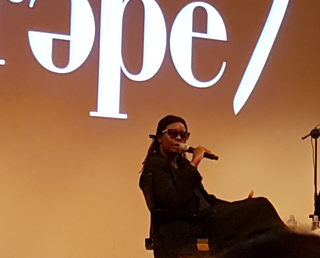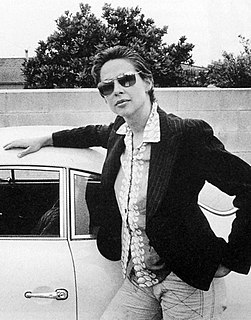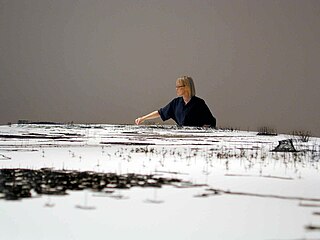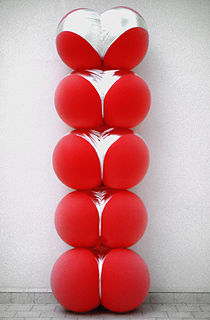
Mickalene Thomas is a contemporary African-American visual artist best known as a painter of complex works using rhinestones, acrylic, and enamel. Thomas's collage work is inspired from popular art histories and movements, including Impressionism, Cubism, Dada and the Harlem Renaissance. Her work draws from Western art history, pop art and visual culture to examine ideas around femininity, beauty, race, sexuality, and gender.

Roger Brown was an American artist and painter. Often associated with the Chicago Imagist groups, he was internationally known for his distinctive painting style and shrewd social commentaries on politics, religion, and art.
Deb Sokolow is an American visual artist who lives and works in Chicago. Sokolow’s work uses both image and text to conjure connections among historical events, celebrities, politicians, and her own personal history in order to spur new consideration of alternate possible realities. Her work has been exhibited widely and is part of a number of permanent collections, including the Hirshhorn Museum and Sculpture Garden, the Los Angeles County Museum of Art, Chicago's Museum of Contemporary Art, the Scottsdale Museum of Contemporary Art, and the Spertus Museum.
Susan Charna Rothenberg was an American contemporary painter, printmaker, sculptor, and draughtswoman. She became known as an artist through her iconic images of the horse, which synthesized the opposing forces of abstraction and representation.
Linda Connor is an American photographer living in San Francisco, California. She is known for her landscape photography.

Lynda Benglis is an American sculptor and visual artist known especially for her wax paintings and poured latex sculptures. She maintains residences in New York City, Santa Fe, New Mexico, Kastellorizo, Greece, and Ahmedabad, India.

Anne Wilson is a Chicago-based visual artist. Wilson creates sculpture, drawings, Internet projects, photography, performance, and DVD stop motion animations employing table linens, bed sheets, human hair, lace, thread and wire. Her work extends the traditional processes of Fiber art to other media. Wilson is a professor in the Department of Fiber and Material Studies at The School of the Art Institute of Chicago.
Stephen Lapthisophon is an American artist and educator working in the field of conceptual art, critical theory, and disability studies.
Tony Tasset is an American multimedia artist. His works consists mainly of video, bronze, wax, sculpture, photography, film, and taxidermy. He has exhibitions that can be seen in Dallas, Chicago, New York, Los Angeles, Germany, Canada, Portugal, Italy, Ecuador, and London.

Nancy Davidson is an American artist best known for large-scale inflatable sculptures regarded as hyper-feminized abstractions of the human female form. Bulbous and flesh-like, the sculptures resemble buttocks and breasts and employ erotic cultural signifiers in their shape and decoration. Davidson's work spans art media but centers around sculpture. It is largely post-minimal in character and described by commentators as providing a feminist counterpoint to the male-dominated, minimalist sculpture of the 1960s, as well as to cultural tropes involving bodies that the works themselves invoke. Of particular note are Davidson's use of humor and a sense of absurdity to seemingly both celebrate and subvert these tropes, inviting their investigation but without the seriousness and moralism that often accompany critical works. Sculpture Magazine critic Robert Raczka wrote that "The confectionary color and oversize scale" of Davidson's sculpture creates a "playfully upbeat mood that allows feminist and gender issues to rise to the surface at irregular intervals, without didacticism." The New Art Examiner's Susan Canning described it as establishing "a context where all can revel in the transgressive and liberating power of the grotesque."

Laura Owens is an American painter, gallery owner and educator. She emerged in the late 1990s from the Los Angeles art scene. She is known for large-scale paintings that combine a variety of art historical references and painterly techniques. She lives and works in Los Angeles, California.
John Geldersma is known for his wooden sculptures of, what he calls, "contemporary tribalism".

Phyllis Bramson is an American artist, based in Chicago and known for "richly ornamental, excessive and decadent" paintings described as walking a tightrope between "edginess and eroticism." She combines eclectic influences, such as kitsch culture, Rococo art and Orientalism, in juxtapositions of fantastical figures, decorative patterns and objects, and pastoral landscapes that affirm the pleasures and follies of romantic desire, imagination and looking. Bramson shares tendencies with the Chicago Imagists and broader Chicago tradition of surreal representation in her use of expressionist figuration, vernacular culture, bright color, and sexual imagery. Curator Lynne Warren wrote of her 30-year retrospective at the Chicago Cultural Center, "Bramson passionately paints from her center, so uniquely shaped in her formative years […] her lovely colors, fluttery, vignette compositions, and flowery and cartoony imagery create works that are really like no one else's. Writer Miranda McClintic said that Bramson's works "incorporate the passionate complexity of eastern mythology, the sexual innuendos of soap operas and sometimes the happy endings of cartoons." Bramson's work has been exhibited in exhibitions and surveys at the Museum of Contemporary Art, Chicago (MCA), the Art Institute of Chicago, the Smithsonian Institution, and Corcoran Gallery of Art. In more than forty one-person exhibitions, she has shown at the New Museum, Fort Wayne Museum of Art, Boulder Art Museum, University of West Virginia Museum, and numerous galleries. She has been widely reviewed and recognized with John S. Guggenheim and Rockefeller foundation grants and the Anonymous Was A Woman Award, among others. She was one of the founding members of the early women's art collaborative Artemisia Gallery and a long-time professor at the School of Art and Design at the University of Illinois at Chicago, until retiring in 2007.

Polly E. Apfelbaum is an American contemporary visual artist, who is primarily known for her colorful drawings, sculptures, and fabric floor pieces, which she refers to as "fallen paintings". She currently lives and works in New York City, New York.
Laylah Ali (born 1968, Buffalo, New York) is a contemporary visual artist known for paintings in which ambiguous race relations are depicted with a graphic clarity and cartoon strip format.
Susan Michod is an American feminist painter who has been at the forefront of the Pattern and Decoration movement since 1969. Her work "consists of monumental paintings [which are] thickly painted, torn, collaged, spattered, sponged, sprinkled with glitter and infused with a spirit of love of nature and art," the art critic Sue Taylor has written.
Nairy Baghramian is an Iranian-born German visual artist. Since 1984, she has lived and worked in Berlin.
Thomas Kovachevich is an American contemporary visual artist and physician. Kovachevich's art practice is multi-faceted; exhibitions of paintings, sculptures, installations and performances have represented the lexicon of this artist.
Jim Isermann is an American artist. He is based in Palm Springs and Guerneville, California. In 1977 he graduated from University of Wisconsin-Milwaukee and then received an MFA from CalArts in 1980. His artwork has focused on post-war industrial design and architecture. He has participated in numerous exhibitions in art galleries and museum, and has also created large scale commissioned projects utilizing industrial manufacturing processes. His work has been presented in solo exhibitions at Richard Telles, Los Angeles, Praz-Delavallade, Paris (2010), Corvi-Mora, London (2011), Mary Boone Gallery, New York and others. Recent commissioned projects include works for the Hammer Museum in Los Angeles, CA, Yale University Art Museum in New Haven, CT, University of California, Riverside, Los Angeles Metro, and an installation for the Cowboys Stadium in Dallas, TX.
Joan Livingstone is an American contemporary artist, educator, curator, and author based in Chicago. She creates sculptural objects, installations, prints, and collages that reference the human body and bodily experience.











